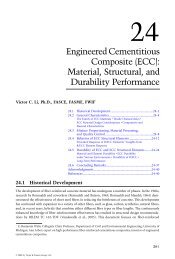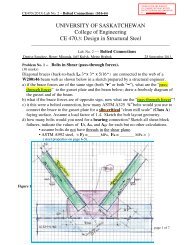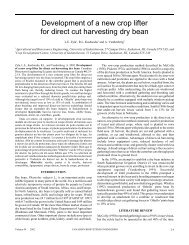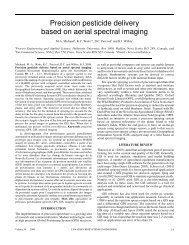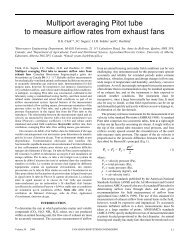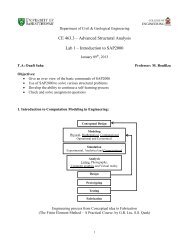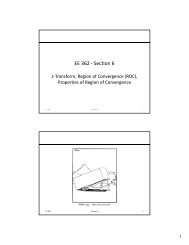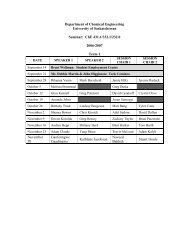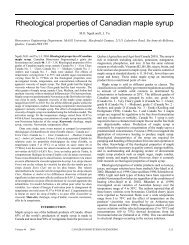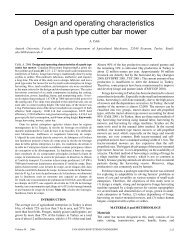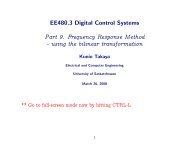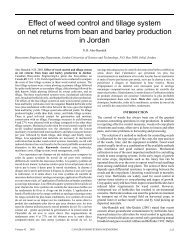Research Report 2009-2010 - College of Engineering - University of ...
Research Report 2009-2010 - College of Engineering - University of ...
Research Report 2009-2010 - College of Engineering - University of ...
Create successful ePaper yourself
Turn your PDF publications into a flip-book with our unique Google optimized e-Paper software.
space are strongly controlled by energetic particles and electric and magnetic fields<br />
carried by the solar wind. Addition <strong>of</strong> PolarDARN radars provides an opportunity for<br />
studies <strong>of</strong> the ionospheric and magnetospheric processes in the area called the “polar<br />
cap” which surrounds the Earth’s magnetic pole, a region which had been unreachable<br />
by the SuperDARN radars prior to the PolarDARN project. The main themes <strong>of</strong> recent<br />
research include global-scale plasma convection patterns and their reconfiguration in<br />
response to changes in the interplanetary magnetic field, plasma physics <strong>of</strong> ionospheric<br />
irregularities, ionospheric signatures <strong>of</strong> energy transfer from the magnetosphere to the<br />
ionosphere, and the physics <strong>of</strong> auroral substorms.<br />
The Atmospheric Remote Sensing Group (ARSG) [Pr<strong>of</strong>essors Degenstein, Bourassa<br />
and Llewellyn] in the Institute has continued to develop techniques used to infer<br />
atmospheric constituent information from observations <strong>of</strong> spectrally dispersed limb<br />
scattered sunlight made with the Canadian built OSIRIS instrument. In the past year<br />
members <strong>of</strong> the ARSG have focused their efforts on further development <strong>of</strong> the<br />
SASKTRAN radiative transfer model and SaskMART, a Multiplicative Algebraic<br />
Reconstruction Technique used to infer vertical number density pr<strong>of</strong>iles <strong>of</strong> ozone,<br />
nitrogen dioxide and stratospheric sulphate aerosols directly from the OSIRIS radiance<br />
measurements. In particular the ARSG has developed an ozone retrieval that<br />
incorporates information from both the Chappuis and Hartley-Huggins absorption bands<br />
to extend the upper altitude <strong>of</strong> the ozone measurements to 60 km. This technique has<br />
received considerable attention from a team <strong>of</strong> NASA researchers planning an<br />
operational instrument to monitor ozone for the foreseeable future. As well members <strong>of</strong><br />
the ARSG have advanced the development <strong>of</strong> techniques used to infer information<br />
about stratospheric sulphate aerosols. The techniques now include a method to use the<br />
OSIRIS radiance measurements to determine the size distribution parameters <strong>of</strong> these<br />
particles as well as their number density. The ozone and aerosol data retrieved from<br />
OSIRIS measurements are being used by other members <strong>of</strong> the ARSG to study long<br />
term trends and the exchange processes that occur between the stratosphere and<br />
troposphere. Other members <strong>of</strong> the group have continued to investigate mesospheric<br />
phenomena with the OSIRIS data set. The areas <strong>of</strong> interest include: continued<br />
investigation into the geographic distribution <strong>of</strong> Polar Mesospheric Clouds (PMC) as<br />
well as the sizes and light scattering properties <strong>of</strong> the ice crystals that make up these<br />
clouds; the measurement <strong>of</strong> true ground state (v = 0) hydroxyl from the OSIRIS<br />
observations <strong>of</strong> resonantly scattered sunlight at 308 nm with the goal <strong>of</strong> retrieving the<br />
water vapour concentrations throughout the sunlit mesosphere; the measurement <strong>of</strong><br />
mesospheric temperature pr<strong>of</strong>iles with Oxygen A Band emissions; and continued<br />
investigation <strong>of</strong> the tertiary ozone peak and ozone depletion caused by solar proton<br />
events. Together with the OSIRIS project, members <strong>of</strong> the ARSG are also involved in<br />
other Canadian Space Agency satellite projects such as ACE-SCISAT, and a new<br />
Physics and <strong>Engineering</strong> Physics – <strong>Research</strong> <strong>Report</strong> <strong>2009</strong>-10 Page 129




